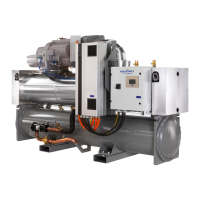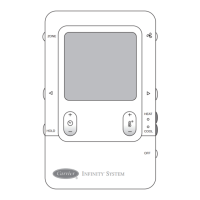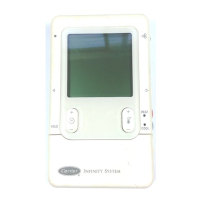Do you have a question about the Carrier Touch Pilot Junior and is the answer not in the manual?
Guidelines for installation, start-up, and servicing of equipment, emphasizing qualified personnel and adherence to instructions.
Precautions regarding electrical components, power shutoff, and handling of potentially hot components.
Description of the Touch Pilot Junior control system for 30RBS/30RQS units, its functions, and connectivity.
Details on how the system controls compressors, fans, and monitors safety devices for optimal operation.
Explanation of the three operating modes: Local, Remote, and Network control.
Features of the Touch Pilot Junior control, including user interface, web connectivity, and remote services.
Overview of how the Touch Pilot Junior controls various unit components like compressors and fans.
Comparison of standard and optional features for Chillers (30RBS) and Heat Pumps (30RQS).
Description of control boards (SIOB, AUX1) and internal LEN bus communication.
Details the electrical box containing control boards and the user interface.
Information on the 24 VAC power supply to boards and restart behavior after interruption.
Explanation of LED indicators on boards for operation status and communication.
Types and functions of pressure transducers used for discharge, suction, and water pressure.
Description of temperature sensors for water, outdoor air, suction gas, and defrost.
Details on actuators like EXV, water flow switch, water heat exchanger pumps, and four-way valve.
Summary of terminal block connections for unit control, setpoint selection, and demand limit.
Explanation of volt-free contacts for unit on/off and cooling/heating selection.
Details on using dry contacts for switching between setpoints in Remote mode.
Description of using dry contacts to limit unit capacity in three steps.
Introduction to the Touch Pilot Junior interface, its screens, and features.
Diagram and explanation of the main menu and configuration menu navigation.
Description of the initial Welcome screen, including application name and software version.
Overview of the Synoptic screen for monitoring the unit's refrigeration cycle and status.
Instructions on how to start the unit and select operating modes (Local, Network, Remote, Master).
Procedure for stopping the unit using the Start/Stop button and confirming shutdown.
Guide to setting occupancy periods for unit start/stop control using time schedules.
How to manage display settings, including language, system of measurement, and user login.
Explanation of user-level security for critical parameter modification and password protection.
Instructions on how to change the display language through the User Login screen.
Procedure to change the system of measurement (Metric/Imperial) via the User Login screen.
Accessing and viewing main control parameters through the Main menu.
Guide to modifying user-configurable parameters via the Configuration menu.
Procedure to override current unit operation using specific configuration screens.
How to access the Touch Pilot Junior control via a web browser.
Instructions for accessing the web interface by entering the unit's IP address.
Minimum web browser configuration requirements and settings for optimal access.
Overview of parameters accessible through the Main menu, categorized by function.
Details of parameters within the Configuration menu, grouped by function (General, Pump, Heat/Cool, etc.).
Detailed list of temperature-related parameters and their descriptions.
Detailed list of pressure-related parameters and their descriptions.
Detailed list of input parameters, including switches and sensor status.
Detailed list of output parameters, including compressor, fan, and valve status.
Detailed list of pump status parameters, including commands and water pressure.
Parameters related to unit and component operating hours and starts.
Parameters for monitoring the DC Free Cooling system status.
Parameters related to various operating modes and conditions.
Configuration of various setpoints, including cooling, heating, and limit setpoints.
Overview of sub-menus within the Configuration menu for parameter setup.
Parameters for general unit configuration, including priority sequence and night mode.
Parameters for configuring pump sequence, delays, and rotation.
Parameters for setting heat/cool changeover, thresholds, and electric heating.
Parameters for configuring cooling and heating reset values.
Parameters for user password and alarm relay settings.
Configuration of unit on/off and setpoint time schedules.
Setup of holiday periods, including start month, day, and duration.
Configuration for CCN broadcast settings like bus number and daylight savings.
Settings for date, time, day of week, and daylight saving time.
Identification parameters like CCN element number, baud rate, and device description.
Accessing alarm history, current alarms, and resetting alarms.
Explanation of factors influencing unit state and how operating types control start/stop.
How the control determines the unit's operating mode (Heating, Cooling, Standby).
Logic for determining operating mode based on control type, selections, and outdoor air temperature.
Methods for selecting cooling or heating modes locally, remotely, or via network.
Information on using boilers or electric heaters for supplementary heating.
How boiler activation is managed based on outdoor air temperature thresholds.
Management of electric heating stages and conditions for activation.
Functionality for managing one or two water exchanger pumps, including start/stop and speed control.
Benefits and methods of controlling variable speed pumps for energy saving and performance.
Basic pump configuration options like sequence and rotation, accessible via the Configuration menu.
How the control balances run time between two pumps and activates reversing functions.
Configuration options for units fitted with external customer pumps.
Features for pump protection, including periodic quick start for bearing and seal longevity.
Functionality of the hydronic kit for monitoring water flow rate and adjusting pump speed.
Definition and verification of the control point, representing the required water temperature.
How active setpoints are selected based on operation type, contacts, network, or schedules.
How setpoints are modified based on OAT or return water temperature to optimize performance.
Setting maximum allowable unit capacity using contacts, lag limit, or night mode.
Adjusting capacity to maintain setpoint, including compressor start/stop sequencing.
Determining the order of circuit capacity changes (Balanced vs. Staged loading).
Lead/lag function for managing start/stop sequences of multiple refrigeration circuits.
Utilizing dry coolers for energy savings by using low outdoor air temperatures for chilling.
Configuring specific parameters and limiting capacity during night periods.
Management of coil pressure in cooling and heating modes for optimal performance and protection.
Defining and managing up to 16 holiday periods for unit operation.
Using BACnet/IP protocol for communication with BMS and programmable controllers.
Utilizing a desuperheater for energy management by extracting heat from refrigerant.
Initiating and managing the defrost cycle to remove frost from outdoor coils.
Controlling two units linked via CCN network, with master handling all commands.
Using the Touch Pilot Junior interface to monitor unit status and detect operating faults.
Accessing the list of active alarms, including date, time, and description.
Methods for resetting alarms manually or automatically through the user interface.
Accessing stored information about resolved alarms.
Association of alarm codes with specific faults and their descriptions.
Configuring e-mail notifications for new alarms or alarm resets.
Comprehensive list of alarms with codes, descriptions, reset methods, actions, and possible causes.
List of common alarms and alerts related to VLT drive and pump drive failures.
Guidelines for installation, start-up, and servicing of equipment, emphasizing qualified personnel and adherence to instructions.
Precautions regarding electrical components, power shutoff, and handling of potentially hot components.
Description of the Touch Pilot Junior control system for 30RBS/30RQS units, its functions, and connectivity.
Details on how the system controls compressors, fans, and monitors safety devices for optimal operation.
Explanation of the three operating modes: Local, Remote, and Network control.
Features of the Touch Pilot Junior control, including user interface, web connectivity, and remote services.
Overview of how the Touch Pilot Junior controls various unit components like compressors and fans.
Comparison of standard and optional features for Chillers (30RBS) and Heat Pumps (30RQS).
Description of control boards (SIOB, AUX1) and internal LEN bus communication.
Details the electrical box containing control boards and the user interface.
Information on the 24 VAC power supply to boards and restart behavior after interruption.
Explanation of LED indicators on boards for operation status and communication.
Types and functions of pressure transducers used for discharge, suction, and water pressure.
Description of temperature sensors for water, outdoor air, suction gas, and defrost.
Details on actuators like EXV, water flow switch, water heat exchanger pumps, and four-way valve.
Summary of terminal block connections for unit control, setpoint selection, and demand limit.
Explanation of volt-free contacts for unit on/off and cooling/heating selection.
Details on using dry contacts for switching between setpoints in Remote mode.
Description of using dry contacts to limit unit capacity in three steps.
Introduction to the Touch Pilot Junior interface, its screens, and features.
Diagram and explanation of the main menu and configuration menu navigation.
Description of the initial Welcome screen, including application name and software version.
Overview of the Synoptic screen for monitoring the unit's refrigeration cycle and status.
Instructions on how to start the unit and select operating modes (Local, Network, Remote, Master).
Procedure for stopping the unit using the Start/Stop button and confirming shutdown.
Guide to setting occupancy periods for unit start/stop control using time schedules.
How to manage display settings, including language, system of measurement, and user login.
Explanation of user-level security for critical parameter modification and password protection.
Instructions on how to change the display language through the User Login screen.
Procedure to change the system of measurement (Metric/Imperial) via the User Login screen.
Accessing and viewing main control parameters through the Main menu.
Guide to modifying user-configurable parameters via the Configuration menu.
Procedure to override current unit operation using specific configuration screens.
How to access the Touch Pilot Junior control via a web browser.
Instructions for accessing the web interface by entering the unit's IP address.
Minimum web browser configuration requirements and settings for optimal access.
Overview of parameters accessible through the Main menu, categorized by function.
Details of parameters within the Configuration menu, grouped by function (General, Pump, Heat/Cool, etc.).
Detailed list of temperature-related parameters and their descriptions.
Detailed list of pressure-related parameters and their descriptions.
Detailed list of input parameters, including switches and sensor status.
Detailed list of output parameters, including compressor, fan, and valve status.
Detailed list of pump status parameters, including commands and water pressure.
Parameters related to unit and component operating hours and starts.
Parameters for monitoring the DC Free Cooling system status.
Parameters related to various operating modes and conditions.
Configuration of various setpoints, including cooling, heating, and limit setpoints.
Overview of sub-menus within the Configuration menu for parameter setup.
Parameters for general unit configuration, including priority sequence and night mode.
Parameters for configuring pump sequence, delays, and rotation.
Parameters for setting heat/cool changeover, thresholds, and electric heating.
Parameters for configuring cooling and heating reset values.
Parameters for user password and alarm relay settings.
Configuration of unit on/off and setpoint time schedules.
Setup of holiday periods, including start month, day, and duration.
Configuration for CCN broadcast settings like bus number and daylight savings.
Settings for date, time, day of week, and daylight saving time.
Identification parameters like CCN element number, baud rate, and device description.
Accessing alarm history, current alarms, and resetting alarms.
Explanation of factors influencing unit state and how operating types control start/stop.
How the control determines the unit's operating mode (Heating, Cooling, Standby).
Logic for determining operating mode based on control type, selections, and outdoor air temperature.
Methods for selecting cooling or heating modes locally, remotely, or via network.
Information on using boilers or electric heaters for supplementary heating.
How boiler activation is managed based on outdoor air temperature thresholds.
Management of electric heating stages and conditions for activation.
Functionality for managing one or two water exchanger pumps, including start/stop and speed control.
Benefits and methods of controlling variable speed pumps for energy saving and performance.
Basic pump configuration options like sequence and rotation, accessible via the Configuration menu.
How the control balances run time between two pumps and activates reversing functions.
Configuration options for units fitted with external customer pumps.
Features for pump protection, including periodic quick start for bearing and seal longevity.
Functionality of the hydronic kit for monitoring water flow rate and adjusting pump speed.
Definition and verification of the control point, representing the required water temperature.
How active setpoints are selected based on operation type, contacts, network, or schedules.
How setpoints are modified based on OAT or return water temperature to optimize performance.
Setting maximum allowable unit capacity using contacts, lag limit, or night mode.
Adjusting capacity to maintain setpoint, including compressor start/stop sequencing.
Determining the order of circuit capacity changes (Balanced vs. Staged loading).
Lead/lag function for managing start/stop sequences of multiple refrigeration circuits.
Utilizing dry coolers for energy savings by using low outdoor air temperatures for chilling.
Configuring specific parameters and limiting capacity during night periods.
Management of coil pressure in cooling and heating modes for optimal performance and protection.
Defining and managing up to 16 holiday periods for unit operation.
Using BACnet/IP protocol for communication with BMS and programmable controllers.
Utilizing a desuperheater for energy management by extracting heat from refrigerant.
Initiating and managing the defrost cycle to remove frost from outdoor coils.
Controlling two units linked via CCN network, with master handling all commands.
Using the Touch Pilot Junior interface to monitor unit status and detect operating faults.
Accessing the list of active alarms, including date, time, and description.
Methods for resetting alarms manually or automatically through the user interface.
Accessing stored information about resolved alarms.
Association of alarm codes with specific faults and their descriptions.
Configuring e-mail notifications for new alarms or alarm resets.
Comprehensive list of alarms with codes, descriptions, reset methods, actions, and possible causes.
List of common alarms and alerts related to VLT drive and pump drive failures.
| Brand | Carrier |
|---|---|
| Model | Touch Pilot Junior |
| Category | Control Panel |
| Language | English |









